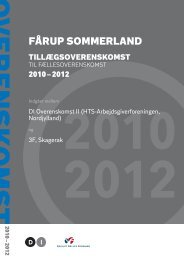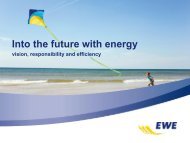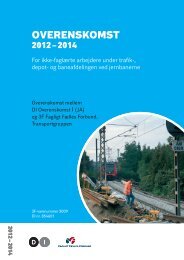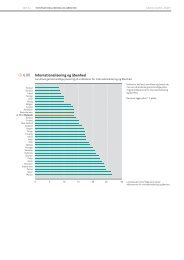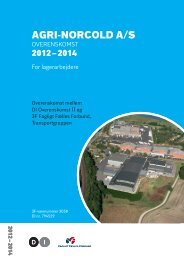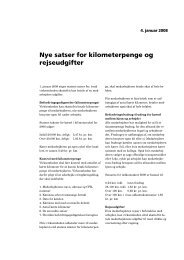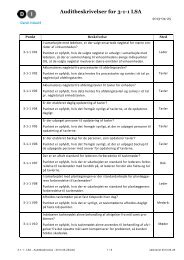Hydrogen and its competitors, 2004
Hydrogen and its competitors, 2004
Hydrogen and its competitors, 2004
You also want an ePaper? Increase the reach of your titles
YUMPU automatically turns print PDFs into web optimized ePapers that Google loves.
42Risø Energy Report 3<strong>Hydrogen</strong> for transport5.4<strong>Hydrogen</strong> for transportANTONIO FUGANTI AND EMANUELE BELLERATE, CENTRO RICERCHE FIAT; ALLAN SCHRØDER PEDERSEN, RISØ NATIONAL LABORATORYIntroductionOne reason to look seriously at hydrogen as an energycarrier is that it can readily be used to power road vehicles,locomotives, ships <strong>and</strong> aircrafts. The most advanceduse of hydrogen in the transport sector is for motor vehicles,especially cars. This is why automotive manufacturersall over the world are putting a lot of money intohydrogen R&D.<strong>Hydrogen</strong> can be used to power vehicles by means ofinternal combustion engines (ICEs), fuel cells or gasturbines. Since fuel cells have higher useful energyconversion efficiencies than simple ICEs, they are veryattractive in automotive applications (see below <strong>and</strong> alsoChapter 5.3).ICEs, however, are a well-established technology that isfairly easy to convert from conventional liquid fuels tohydrogen. For these reasons, some car manufacturers arealso working on ICEs specifically for hydrogen.Most gas turbines today are much too large to be used inroad vehicles. However, R&D in countries includingGermany <strong>and</strong> the USA aims to develop small hydrogenfuelledgas turbines suitable for road vehicles. When usedwith other energy conversion technologies in hybridcycles, gas turbines should be able to match the efficiencyof fuel cells. For this reason, some people believethat gas turbines may be the winning technology inhydrogen for transport applications.<strong>Hydrogen</strong> has been applied for transport purposes inaviation (Russian <strong>and</strong> American aeroplanes) as well as inseveral areas of surface transport (buses, cars <strong>and</strong> trucks).As mentioned, however, the most intense <strong>and</strong> advanceddevelopments have been done in the automobile sector<strong>and</strong> therefore a detailed description hereof is given in thefollowing section.<strong>Hydrogen</strong> from the car manufacturers' pointof viewDrivers <strong>and</strong> technologyEnergy consumption associated with transport isexpected to grow around 2% per year in Europe over thenext few years, <strong>and</strong> much faster in developing countriessuch as China <strong>and</strong> India. Oil is the source of 96% of theenergy currently used in transport.Within this context, automakers face increasingly tightlegal restrictions on polluting emissions. There is alsogrowing public pressure to decrease emissions of carbondioxide <strong>and</strong> other greenhouse gases (GHGs), which areparticularly associated with transport. In Europe, avoluntary agreement by all the car manufacturers has setcarbon dioxide emissions targets of 140 g CO 2 /km for2008 <strong>and</strong> 120 g CO 2 /km for 2012.CO 2 g/km190Refinements in conventional engine technology willprobably be able to keep pace with legislative requirementsfor pollutants such as NOx <strong>and</strong> hydrocarbons. Thetargets for CO 2 , however, require improvements in fueleconomy that conventional engines will probably not beable to meet (because with conventional fuels, a givenamount of energy is always associated with a fixed quantityof CO 2 ).The answer may be to use hydrogen-fuelled internalcombustion engines (ICEs) or fuel cells. ICEs running onhydrogen emit NOx, but since their fuel contains nocarbon, their exhaust contains no CO 2 or hydrocarbons.Fuel cells are more efficient than ICEs, <strong>and</strong> have nomoving parts. When fuelled by hydrogen, they produceonly water. For these reasons, most of the hydrogen R&Dcarried out by automotive manufacturers in recent yearshas focused on fuel cells, particularly proton exchangemembrane fuel cells (PEMFCs). Among the favourablecharacteristics of PEMFCs for transport applications arelow operating temperatures <strong>and</strong> short start-up times.Figure 18 shows the power train of a simple fuel cellvehicle. The fuel cell generates electricity, which drivesan electric motor. Although the fuel cell vehicle has twoseparate energy conversion steps, compared to one in aconventional ICE vehicle, <strong>its</strong> overall efficiency can behigher because the fuel cell <strong>and</strong> especially the electricmotor have very high individual conversion efficiencies.Fuel cells can overcome the problems of range, performance<strong>and</strong> refuelling time associated with traditional electricvehicles, which use accumulators to store electricity.Because chemical energy storage media such as hydrogenhave a higher energy density than accumulators, fuel cellvehicles have better range <strong>and</strong> performance than tradi-165-1701401201995Figure 17: Targets for CO 2 emissions.CEC – ACEA Agreement -26%CEC Review-14%2003 2008 2012 Year



